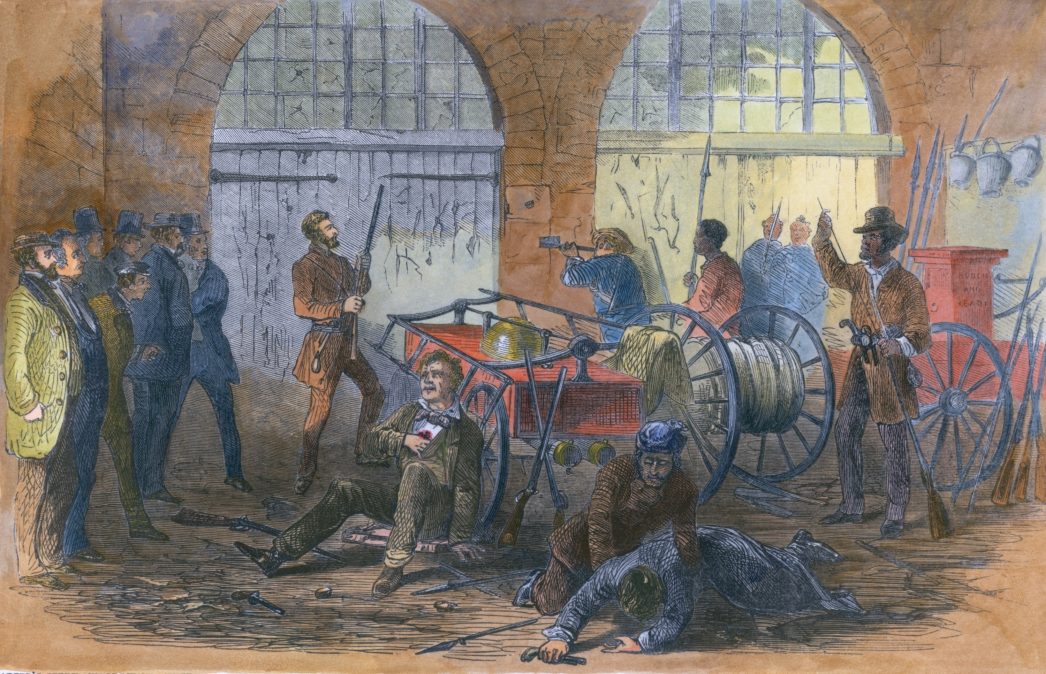Knock. Knock.
Who goes there?
John.
We’ve been expecting you.
Since July, John Brown had been renting a small cabin just four miles north of Harpers Ferry under the name of Isaac Smith. The US government had already caught wind of his plan to raid the United States Armory and Arsenal at Harpers Ferry from an English mercenary that Brown had hired. After hearing the full plan through, this mercenary demanded more money for his services. When Brown wouldn’t agree to more money this mercenary arranged a meeting with two US Senators, William Seward and Henry Wilson, in Washington, DC and warned them of Brown’s plans.
Brown soon received word from one of his backers, a man named Samuel Howe, to stay away from Harpers Ferry and to use the 198 carbines and 950 pikes Brown had already collected for use against pro-slavery conservatives in Kansas.
Kansas?
John Brown and his followers had already murdered five pro-slavery supporters in Pottawatomie, Kansas in retaliation for pro-slavery activists attacking and murdering settlers in Lawrence, Kansas. The killing of five people in a single night sparked a string of retaliatory skirmishes over a three-month period in which 29 people would die.
The Kansas–Nebraska Act of 1854 was a horrible piece of legislation that said that whether or not Kansas became a slave state or a free state would be determined by vote.
All that did was bring about a string of deadly killings as pro-slavery and anti-slavery activists rushed to settle Kansas and soon after began killing each other so that when it came time for this vote whatever side had more people still breathing would win the state.
Well, after John left, the pro-slavery side was short 5 votes.
Brown was warned that the weapons should not be used “for other purposes, as rumor says they may be.”
You know, maybe if John had plans to just raid the armory, maybe steal a few wagons of rifles and be on his way it might’ve worked. But John Brown had every intention of holding it, to arm all of the 200-500 slaves John Brown expected would immediately join him as soon as word got out about what he was doing. His plan then was to send armed slaves back to these nearby plantations and rally the slaves there to join in the fight.
Harpers Ferry contained 100,000 muskets and rifles.
As more slaves answered the call, he would fit them with weapons. He figured there wouldn’t be a militia the U.S. could assemble that would be able to stop them.
If his plan worked, Brown would argue, he and his army of armed slaves would move southward arming enslaved Africans everywhere they could find them, building up an unstoppable tsunami.
If the United States government wanted to stop them they would be forced to go to war against hundreds of thousands of armed enslaved Africans and enslave them again or kill them trying.
Up to the last days before the raid, John Brown was still trying to find more blacks to join him. He again asked Fredrick Douglass to help recruit but again Douglass refused fearing that such a raid against the United States military would only turn public sentiment against their cause, not for their cause. “Besides,” Douglass warned matter-of-factly, “You will never get out alive”.
When John Brown decided to move on Harpers Ferry on October 16, 1859 he did it with 21 men; 16 white men, 3 free blacks, 1 freed slave, and 1 fugitive slave.
Brown and his men quickly put down the first wave of men who showed up to the armory and, briefly, the armory was under his control. Briefly.
By dawn the next morning on October 17, 1850 a local militia, armed farmers and shopkeepers surrounded the armory and cut off any escape route for the raiders. They broke into the armory and rescued several of Brown’s hostages, things didn’t look good for Brown. Brown even sent his son Watson out with a white flag and the militia responded by shooting his son dead.
Brown took his remaining hostages and moved them all to a small fire engine house that became known as John Brown’s Fort.
On the third day, President Buchanan sent in a company of marines run by whom else but Robert E. Lee. The very same Robert E. Lee who would end up leading the Confederate Army in the American Civil War against the United States.
Holed up in a small fire engine house, Lee and his marines took Brown down in no time.
John Brown’s Raid was a complete, unmitigated, out-and-out, utter failure.
Robert Lee, who was on leave when he was recalled to deal with Brown, had to command in his civilian clothes, as he didn’t even have time to change into his uniform.
Lee put the raid down so fast he probably didn’t have time to finish a cup of coffee.
Lee’s official report of the incident was that he believed that John Brown was insane, citing that “…the plan [raiding the Harpers Ferry Arsenal] was the attempt of a fanatic or madman.” What is also interesting is what Lee said about the blacks that helped Brown. “The blacks, whom he [John Brown] forced from their homes in this neighborhood, as far as I could learn, gave him no voluntary assistance.”
John Brown was tried for treason and hanged on December 2, 1860.
On the day of his hanging he wrote these last prophetic words, “I John Brown am now quite certain that the crimes of this guilty, land: will never be purged away; but with Blood. I had as I now think: vainly flattered myself that without very much bloodshed; it might be done.”
Among attendance for John Brown’s public hanging was John Wilkes Booth, who we all know would later assassinate President Abraham Lincoln.
As seems to be typical of the American political landscape there emerged two completely different takes of John Brown’s raid on Harpers Ferry.
On one hand pro-Slavery conservatives pointed to the fact that slaves didn’t rush to aid Brown like he had assumed would happen. In their opinion, this was evidence to what they had been saying all along in their romantic pro-slavery “plantation literature”, that slaves were well treated and content being their slaves.
What pro-slavery conservatives were incensed about though was that white abolitionists in the north had supplied John Brown with 198 carbines and 950 pikes. This meant that opposition against the South’s “peculiar institution” had gotten to the point that they were willing to see blood shed over this issue.
Slave owners first great fear was that free blacks, blacks that they didn’t have a constant eye on, would use their freedom to assist their slaves to rebel against them (Denmark Vesey). Their second fear was that their slaves would sneak into their homes in the middle of the night and kill them in their own beds while they slept (Nat Turner). Their third fear, literally their worst nightmare, was that northern white abolitionists would be willing to actively participate in aiding a slave revolt.
The South was also taken aback at the number of Northerners and Northern newspapers that openly supported John Brown’s attempted slave insurrection at Harpers Ferry. Many southerners felt that they could no longer live with compatriots who advocated that the South’s white population be murdered in their sleep.
Many southerners said that if a Republican were ever to be elected President, it would be as if the North had risen a banner on which is inscribed “death to the institutions of the South” and they could no longer remain in the same confederacy with “them”.
Abraham Lincoln, a Republican, was elected President 13 months later.
And the south stayed true to their word.
In February of 1861, delegates from seven southern states met in Montgomery, Alabama and formed a new federation. Of the fifty delegates that attended, 49 were slave owners and 21 were full-fledge planters.
What’s the difference?
According to the US census, the title of Planter was reserved for slave owners that owned a minimum of twenty slaves. Only one out of eight slave owners belonged to this “Planter” group, but collectively they controlled more than half of all the South’s entire slave population and the vast majority of its total wealth.
These were the men who were delegates at the Confederacy’s constitutional convention in Montgomery, Alabama on February 4, 1861 and they chose Jefferson Davis, the Senator from Mississippi that wanted to take over Cuba to expand slavery, to be their new President.
Davis would learn of their decision while he was at his plantation in Mississippi watching his 113 slaves keep him rich. Davis claimed that he never wanted the job but only accepted it out of “duty” to his new country.
It wasn’t all bad though. Maybe now he could take over Cuba.

